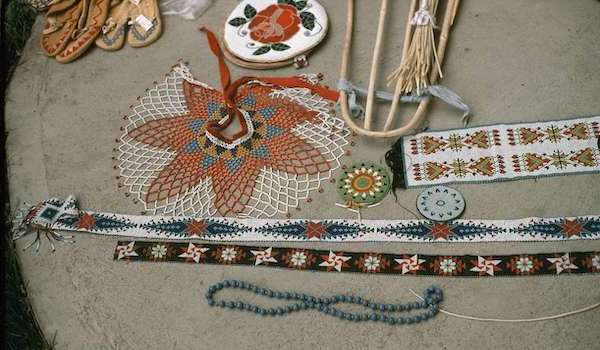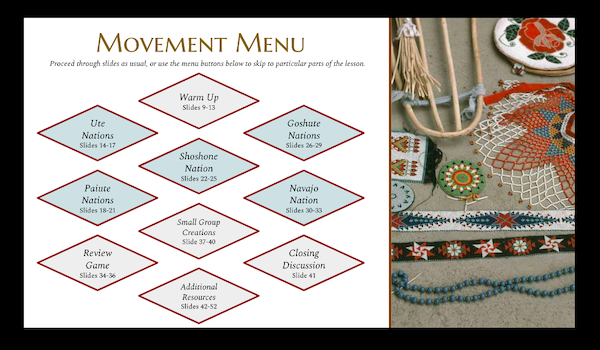SUBJECTS
GRADE
Show Results
5 Tribal Groups, 8 Sovereign Nations

Lesson Summary
- Learn about the eight sovereign nations derived from the five Native American tribes within Utah.
- Engage in small group and individual creative dance explorations.
- Analyze the unique, defining attributes of each tribe and sovereign nation.
Lesson Plan and Procedure
Lesson Key Facts
- Grade(s): K, 1, 2, 3, 4, 5, 6
- Subject(s): Dance, English Language Arts, Social Studies, Native American
- Duration of lesson: Varies
- Author(s): Rachel Marie Kimball and Brenda Beyal
This lesson content was developed in answer to the question, “What would Native tribes in Utah like the students of Utah to know about them?” Before teaching this lesson, please explain to your students that while there are many Native tribes in the United States, this lesson specifically focuses on experiences of the eight sovereign nations within Utah and does not represent other Indigenous groups, unless specifically identified. Representatives from the eight Sovereign Nations of Utah worked together with Rachel Marie Kimball in crafting this lesson to provide expertise, accuracy, and authenticity.
We invite teachers to explore movement concepts connected to learning about and from the five tribal groups, and more specifically the eight sovereign nations located in Utah. The slide presentation includes everything needed for the lesson. Access the slide presentation to begin your adventure. Proceed through the slides as usual or use the menu buttons on slide 8 to skip to specific parts of the lesson.

Learning Objectives
- Understand the difference between Native American tribal groups and sovereign nations recognized by the federal government.
- Appreciate unique attributes of tribal groups and sovereign nations in the Utah area.
- Demonstrate a variety of dance qualities individually and in small groups.
Utah State Board of Education Standards
This lesson can be used to meet standards in many grades and subject areas. We will
highlight one grade’s standards to give an example of application.
Grade 2 Dance
- Standard 2.D.CR.2: Explore movement inspired by a variety of stimuli.
- Standard 2.D.P.4: Demonstrate clear pathways and intent when performing locomotor and non-locomotor movements.
Grade 2 Social Studies
Strand 1: History: Students use historical thinking skills to explore continuity and change in their community, Utah, and the United States.
Standard 2.1.1: Use primary sources (for example, artifacts and documents such as interviews, photographs, newspapers, speakers, stories, songs) to document the chronology of important events in their personal, family, school, local, or broader community history (including three significant events).
Standard 2.1.2: Use primary sources to identify how their community has changed or remained the same over time, and make inferences about the reasons why.
Standard 2.1.5: Identify the achievements of significant Americans, including those from local and other diverse perspectives, and explain their importance.
Standard 2.2.5: Describe and give examples of interdependent relationships between vegetation, animal life, geographic features, and people specific to a local region (for example, irrigation, water conservation, farming, helping neighbors, ranching, providing vegetation that supports pollinators, protection of endangered animals).
Standard 2.2.6: Identify natural resources, and cite ways people show stewardship through responsible use, conservation, protection, and replenishment.
Standard 2.2.7: On a map of the world, locate where their families or other families in the community historically came from. With support, curate and share information about the traditional food, cultural customs, recreation, religion, and music of that country and/or region.
Grade 2 Language Arts
- Standard 2.R.12: Demonstrate understanding of story elements and/or topics by applying information gained from illustrations or text features. (RL & RI)
Equipment and Materials Needed
- 5 Tribal Groups, 8 Sovereign Nations slide presentation
- Possible Native music to dance with:
- Many traditional Native American songs and music are reserved for traditional dances and specific settings in Native cultures. To respect and honor the significance of traditional songs and music, we are providing a list of modern music produced by Native American artists.
Additional Resources
This lesson was created thanks to a grant from the National Endowment for the Arts and the Utah Division of Arts & Museums.
- Utah's Eight Tribal Nations
- Navajo Nation Website Link
- Northwestern Band of the Shoshone Website Link
- Ute Indian Tribe Website Link
- Ute Mountain Ute White Mesa Website Link
- Confederated Tribes of the Goshute Website Unavailable (Utah Gov Website)
- Skull Valley Band of the Goshute Website Unavailable (Utah Gov Website)
- Paiute Indian Tribe of Utah Website Link
- San Juan Southern Paiute Tribe Website Link
- Katie Holliday Beadwork on Etsy
Image References
Lesson Overview Image 1:
https://picryl.com/media/paiute-indian-beadwork

www.education.byu.edu/arts/lessons
 Download
Download